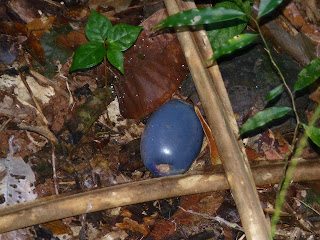Tuesday 23rd
June
On Tuesday we went on two rainforest walks.
 |
| This is a frog that we saw in morning. |
 |
| This is a baby turtle. Can you see it? |
On the second rainforest walk we saw a strangler fig that had curled around another tree and the other tree had rotted away to make a
funny hollow bit in the middle.
 |
| This is the funny tree. |
Here are some other things we saw.
 |
| This is a catapiller that looks like loon bands. |
 |
| This is a brushturkey or a orange-footed scrubfowl mound. |
 |
| This is a vine. |
Mum's note:
We had a lovely time in the Daintree, it is so Alive. Apart from all the creatures and plants mentioned by Isabel we also saw lots of brushturkeys, a orange-footed scrubfowl, jungle perch and other fish, mud crabs, and a Birdwing butterfly. We are not sure whether the mound belongs to the brushtrukey or scrubfowl, as both belong to the megapode family that build such nests.
 |
| Mud crabs in the mangroves. |
 |
| A cricket (or similar) that Caleb found. |
 |
| No prizes for guessing why the turtles here are named Saw-backed turtles. |
After the mangrove walk the kids played on the beach for a while. Caleb built a sand volcano, which then proceeded to erupt ash and lava over the area marked by the roughed-up sand. His mission? "It's Pompeii, of course!"
 |
| Caleb helping the volcano destroy Pompeii. |
Finally, on the way back to Cairns, I couldn't resist taking a photo of this little act of vandalism that tickled my funny bone....
 |
| And no, we didn't see any cassowaries in either pose. |

















































